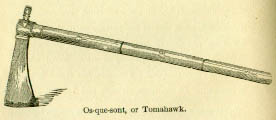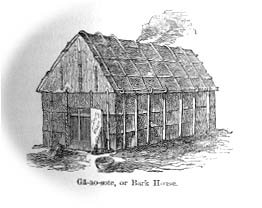|
The time line is divided into year, the event in Mary's life, other events in America, additional notes relating to the Jemison story, and the sources. All quotes are from Mary Jemison's narrative unless otherwise noted. They have been also put in italics. Please note that after her adoption, the names "Mary Jemison" and "Dehgewanus" are interchangeable. The illustrations come from the 1898 edition of Seaver's work edited by Mr. Letchworth. For more information, see our Glimpse of Mary Jemison, and other material on her life in found in the Mary Jemison section our "Pieces of the Past."
|
|
|
|
|
|
|
|
|
Mary is born to Thomas and Jane Erwin Jemison somewhere on the Atlantic while sailing on the William and Mary from Belfast, Ireland to Pennsylvania | Thomas Jefferson born; Ben Franklin organizes the American Philosophical Society | It is thought the ship William and Mary arrived at Philadelphia on October 6, 1743 | Seaver:309-310 |
|
|
Jemison Family begin life on the frontier at Marsh Creek, near present day Gettysburg, Pennsylvania | King George's War between France and England begins | Seav er :311-312 | |
|
|
Many years later Mary recalled that " Peace attended their (her family's) labor...the morning of my childish, happy days, will ever stand fresh in my remembrance...." | The end of King George's war bring peace on the frontiers. | Seaver :20-21 | |
|
|
French begin a series of forts in the Ohio Valley | |||
|
|
Mary's uncle marches with the Virginia Militia under George Washington. John Jemison is killed at the Battle of Great Meadows (Fort Necessity) "after the surrender ... the French and Indians grew more terrible." | French build Fort Duquesne (Pittsburgh), French and Indian War begins | John Jemison's widow and child came to live with Mary's family for a while | Seaver:21 |
|
|
 |
General Braddock and army defeated near Ft Duquesne - western frontier in flames | ||
|
|
Wednesday, April 5, 1758. Jemison homestead is attacked by a war party of French and Shawnee. Brothers escape, rest of the Jemisons are captured along with neighbors. Only Mary and a neighbor are alive when party arrives at Ft. Duquesne. Mary taken by Seneca women to town on the Ohio and adopted. |
French abandoned Ft Duquesne in November. | "Breakfast was not yet ready, when we were alarmed by the discharge of a number of guns that seemed to be near. Mother ...almost fainted at the report, and every one trembled with fear....They first secured my father, and then rushed into the house, and without the least resistance made (us) prisoners...." |
Seaver: 24,25,314 Beauchamp:190 |
|
|
Mary, adapting to the Seneca life, travels with village to Fort Pitt "to make peace with British". She remembered "the white people were surprized to see me with the Indians, enduring the hardships of a savage life, at so early an age." Her Seneca family fear she will be taken, return to their village. | As the Seneca "Dehgewanus" she is learning her new life and states that she had at this time "become habituated to their mode of living, and attached to my sisters...." | Seaver: 42,43 | |
|
|
Seneca move to "Wiishto" on the Ohio and join Delaware. Mary's sisters "told me that I must go and live with one of them, whose names was Sheninjee....(we) were married according to Indian customs" |
|
Mary would remember Sheninjee as "ever kind in sickness, and always treated me with gentleness...he was an agreeable husband and a comfortable companion...." | Seaver:44 |
|
|
Mary's first child is born. "My two sisters ... attended me, and on the second day...my child was born; but it lived only two days. It was a girl...it was a great grief to me to lose it...." |
 |
Seaver:45 | |
|
|
Late winter - Mary gives birth to son "to commemorate the name of my much lamented father, I called my son Thomas Jemison." Sheninjee decides to move Dehgewanus to Genesee Valley, small party travels over 500 miles, Sheninjee separates from the party to hunt, but Mary and little Thomas reach the Genesee river by late fall. | Iroquois leaders meet with British at Onondaga, among agreements is the return of all white captives. | Dehgewanus later told of the "fatigue and sufferings ...endured on that journey..." and the warm welcome she received at Genishua (Little Beard's Town) | Seaver:43,54 |
|
|
Summer- Mary learns that Sheninjee died the past fall. "I was now ...a widow with one son,...my (Seneca) mother and her family gave me all the consolation in their power, and in a few months my grief wore off and I became contented...." | French and Indian War ends, French cedes most of North American to British - Pontiac's War to the west. | Seaver::58 | |
|
|
Mary eludes capture by Dutchman John Van Sice who wanted to claim a bounty for the return of white captives. | Passage of the Sugar Act causes protests by British colonists in the 13 colonies | Beginning of about a dozen years of peace for Seneca along the Genesee River | Seaver:58-61 |
|
|
Mary is married to the Seneca Hiokatoo. "Hiokatoo was an old man when I first saw him; but he was by no means enervated. During the term of nearly fifty years that I lived with him, I received, according to Indian customs, all the kindness and attention that was my due as his wife...he uniformly treated me with tenderness, and never offered an insult...." | Sons of Liberty lead opposition to Stamp Act and Quartering Act. | Seaver:104 | |
|
|
Mary gives birth to her son John. | First Letchworth arrives in America from England. John Letchworth, WPL's great-grandfather settles in Philadelphia. | Of this time period Mary later recalled - "at peace amongst themselves, and with the neighboring whites, though there were none at the time very near, our Indians lived quietly and peaceable at home...." | Seaver: 64; 357 |
|
|
Little Beardstown or Dyu-non-dah-ga-eeh is considered one of the main towns among the western Seneca. It was described by a soldier who would help destroyed it in 1779 as having "one hundred and twenty eight houses, mostly very large and elegant. The town was beautifully situated, almost encircled with a clear flat which extends for a number of miles were the most extensive fields of corn were, and every kind of vegetable that can be conceived. " | Future New York Governor and canal promoter DeWitt Clinton is born in Orange County | Doty: 87-88 | |
|
|
Mary is twenty seven years old. | Boston Massacre takes place as unrest grows in the Colonies. | ||
|
|
Mary's first surviving daughter Nancy is thought to be born around this year. A second daughter Betsy is born over the next two or three years at Little Beard's Town | Boston Tea Party is held by "Indians" in Boston harbor. | Seaver:357 | |
|
|
Intolerable Acts passed, the 1st Continental Congress is held. | Sir William Johnson, Supt of Indian Affairs for British dies in Mohawk Valley | ||
|
|
In August the Seneca and other Iroquois meet in with Americans at German Flats, agree to remain neutral. Mary remembered that the Seneca "returned to their homes well pleased that they could live on neutral ground surrounded by the din of war..." | April - 1st shots fired at Lexington, American Revolution begins, Washington appointed commander in chief in May | Seaver:65 | |
|
|
 |
Colonies declare their Independence, Americans begin to recruit Indian Allies - Oneida and Tuscaroras side with Americans | Mary stated in 1823 that "Many of the kettles which the Indians received at that time (at the Oswego Council) are now in use on the Genesee Flats." | Seaver:66,67 |
|
|
British messenger arrives at Little Beardstown in early Summer calling a Council at Oswego. British pressure and gifts change attitudes and the Seneca returned to Beardstown " richly clad and equipped...full of the fire of war, and anxious to encounter their enemies..." Seneca fight at Oriskany in August. Heavy losses to Little Beardstown - 36 killed and many wounded. | British Three Fold Plan to capture New York fails, Burgoyne surrenders at Saratoga in October. | "Our town exhibited a scene of real sorrow and distress...the mourning was excessive...." |
Seaver:66-68 Abrams: 34 |
|
|
"...my house was the home of Col's Butler and Brant, when ever they chanced into our neighborhood.... Many and many a night I have pounded samp for them...and furnished them with necessary provision and clean clothing for their journey...." | Frontier raids carried out by British and Indian Allies. Ft. Niagara and Genesee Valley staging ground for the raids led by John Butler and Mohawk Joseph Brant. Cherry Valley and Wyoming Massacres. | "...our tribe, because of the remoteness of its situation from the enemy, felt secure from an attack" | Seaver:69 |
|
|
Daughter Polly is probably born in the springtime. Sullivan and Clinton Expedition ordered into the Genesee Valley by George Washington to destroy Seneca homeland and capture Ft. Niagara. Little Beardstown destroyed, Mary and her five children go to Gardeau Flats. | Many villages destroyed by advancing American Army, including Little Beardstown. Army withdraws in the fall without attacking Ft. Niagara. | "...they destroyed every article of food kind that they could lay their hands on. A part of our corn they burnt, and threw the remainder into the river. They burnt our houses, killed what few cattle and horses they could find, destroyed our fruit trees, and left nothing but the bare soil and timber. But the Indians had eloped and were not to be found....as we were destitute of houses and food too...I took two of my little ones on my back, bade the other three follow, and the same night arrived on the Gardow flats, were I have ever since resided...." | Seaver:73,74 |
| For more information, see our Glimpse of Mary Jemison, and other material on her life in found in the Mary Jemison section our "Pieces of the Past." |